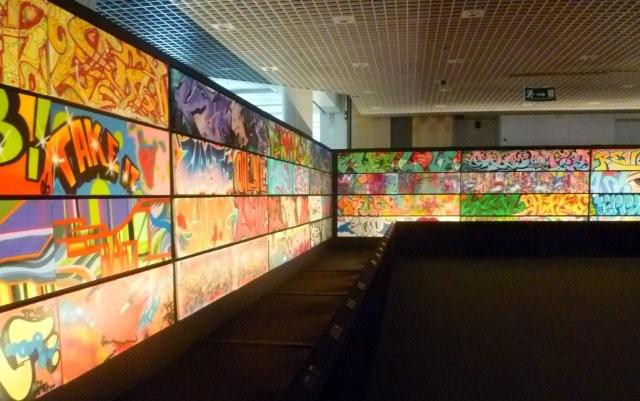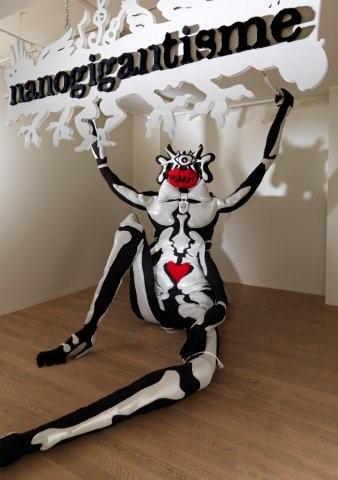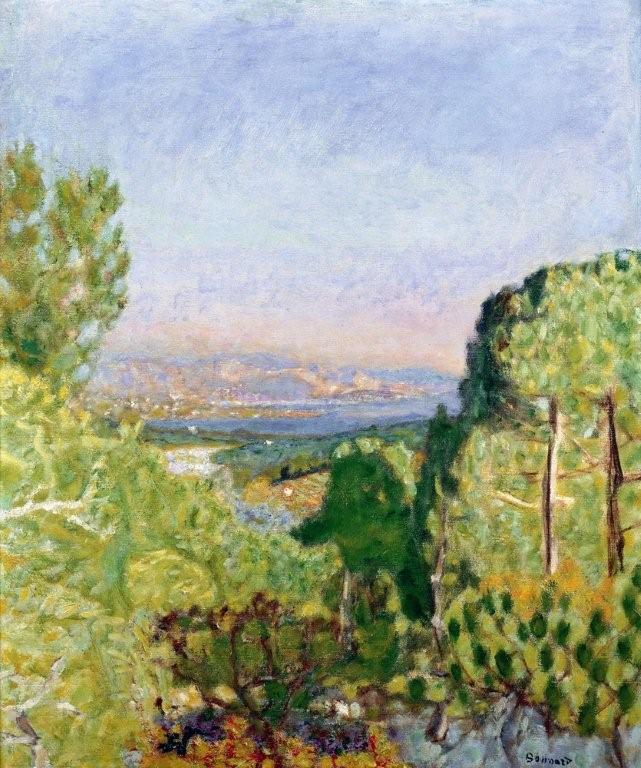Where Graffiti is a Rarefied Art | reviews, news & interviews
Where Graffiti is a Rarefied Art
Where Graffiti is a Rarefied Art
A feast of exhibitions from Monaco to Cannes
Monaco, dormitory town of the discreetly super-rich, isn’t the most obvious place to find a major exhibition of street art, the subject on which many recent commenters on theartsdesk are impassioned. The pavements of this city within a principality on the scale of village, clinging to a precipitous Mediterranean hillside above a gleaming marina, betray barely a trace of chewing gum or dog excrement, let alone graffiti.
Gaining professional access to The Art of Graffiti – 40 Years of Pressionism in the glass bunker of the Grimaldi Forum, the journalist is subjected to a level of scrutiny you’d expect of entry into some high-security bank.
Yet seeing this work in a place so remote from the world of sink estates and screaming sirens that created it certainly gives you a refreshingly different angle. That sense felt in many street art exhibitions that what has been brought into the gallery can hardly compete with the viscerality of what’s outside hardly pertains here. In Monaco graffiti feels as exotic and as rarefied as, say, Indian miniatures or early-Italian altarpieces.
While many of the artists are French, the tradition of political street art typified by Blek le Rat (from whom Banksy lifted many of his chops) isn’t represented here. What we have is US-style tag graffiti transposed to uniformly sized canvases that glow out of the darkened rooms like so many DayGlo stained-glass windows (pictured below).

The long, narrow formats designated by curator and collector Alain-Dominique Gallizia – who coined the term "Pressionism" from the pressure exerted on the spray-can nozzle – refer to the panels on the hoardings round the refurbishments to the Louvre on which many French graffiti artists learned their “craft”.
The distinctions here are between those artists who simply transfer something you’d expect to see on a hoarding or subway train onto canvas (Terror 161, T-Kid 170 and more than half of the artists in the show), those who inflate the tropes of graffiti into a rather crass form of illustration (Sonic and Nascio), and those who take it to a level of self-consciousness where it becomes Art with a capital A (Crash 1996 and Quik, whose work sassily combines Lichtenstein and Koons probably without even intending to [see main picture above]).
 A whole room is devoted to veteran New Yorker Rammellzee, whose incorporation of collage illustrates the dilemma of the street artist who moves off the outside wall and into the gallery. People will inevitably ask if his amalgams of paint and found imagery have the formal coherence of Schwitters and Rauschenberg. In fact they don’t, but they have another kind of energy that hasn’t yet been defined or explored.
A whole room is devoted to veteran New Yorker Rammellzee, whose incorporation of collage illustrates the dilemma of the street artist who moves off the outside wall and into the gallery. People will inevitably ask if his amalgams of paint and found imagery have the formal coherence of Schwitters and Rauschenberg. In fact they don’t, but they have another kind of energy that hasn’t yet been defined or explored.
Across the road in the Belle Epoque Villa Sauber, the National Museum of Monaco is presenting the eighth in a series of exhibitions responding to its extraordinary collection of vintage dolls and automata. After last year’s exuberant outing from Yinka Shonibare, cult Parisian design collective On Aura Tout Vu (which they translate as "You’ll have seen it all now") present a baroque essay in nightmarish cuddly toys and carnival-disco chic. Dolls of local icons Prince Rainier and Princess Grace appear through clouds of gauze. A glass-eyed Second Empire ball stands beside a doll-sized 1970s disco.
If the experience is akin to being trapped in some über-stylish department store window, the best exhibits, including a room-size black velvet monster (pictured left above) with an orchestra of vintage clockwork monkey musicians embedded in his back, just about transcend mere outré chic.
West of Nice, the winding, cliff-bound corniches give way to a multi-lane highway promenade endlessly unrolling past a more than slightly scuzzy array of car showrooms, casinos and monster apartment blocks. Dotted along the route are museums devoted to the figures who made this part of the world synonymous with art: Matisse and Chagall in Nice, Léger in Biot, Renoir in Cagnes-sur-Mer, Picasso at Antibes and Vallauris.
 Latest in this heroic roll call is the new Bonnard Museum at Le Cannet, just north of Cannes, which opened in June in a drastically modernised period villa. If almost nothing of the interior remains, it makes an effective viewing space, and the opening exhibition, which mixes intimate drawings scrawled in the artist’s diaries from the museum’s own collections with top-quality loans from the Musée d’Orsay and Tate, vividly evokes a time when the area was still relatively undiscovered, an exotic point of escape from drab, grey Paris (see Le forêt des pins, pictured right).
Latest in this heroic roll call is the new Bonnard Museum at Le Cannet, just north of Cannes, which opened in June in a drastically modernised period villa. If almost nothing of the interior remains, it makes an effective viewing space, and the opening exhibition, which mixes intimate drawings scrawled in the artist’s diaries from the museum’s own collections with top-quality loans from the Musée d’Orsay and Tate, vividly evokes a time when the area was still relatively undiscovered, an exotic point of escape from drab, grey Paris (see Le forêt des pins, pictured right).
Bonnard, who can seem a decorative and indecisive also-ran to the great Post-Impressionists, remains compellingly elusive. His views of gardens, bathrooms and dining tables shimmering in iridescent reflected light speak of a Côte d’Azur we all dream of experiencing. Yet the opportunities for solitude and contemplation he found here are rapidly vanishing as the area merges into one long, sprawling urban village.
- On Aura Tout Vu présente la Collection de Galéa is at the NMNM-Villa Sauber until 29 January, 2012
- La Musée Bonnard is at 16 bd Sadi Carnot, Le Cannet
more Visual arts
 Yinka Shonibare: Suspended States, Serpentine Gallery review - pure delight
Weighty subject matter treated with the lightest of touch
Yinka Shonibare: Suspended States, Serpentine Gallery review - pure delight
Weighty subject matter treated with the lightest of touch
 Jane Harris: Ellipse, Frac Nouvelle-Aquitaine MÉCA, Bordeaux review - ovals to the fore
Persistence and conviction in the works of the late English painter
Jane Harris: Ellipse, Frac Nouvelle-Aquitaine MÉCA, Bordeaux review - ovals to the fore
Persistence and conviction in the works of the late English painter
 Sargent and Fashion, Tate Britain review - portraiture as a performance
London’s elite posing dressed up to the nines
Sargent and Fashion, Tate Britain review - portraiture as a performance
London’s elite posing dressed up to the nines
 Zineb Sedira: Dreams Have No Titles, Whitechapel Gallery review - a disorientating mix of fact and fiction
An exhibition that begs the question 'What and where is home?'
Zineb Sedira: Dreams Have No Titles, Whitechapel Gallery review - a disorientating mix of fact and fiction
An exhibition that begs the question 'What and where is home?'
 Yoko Ono: Music of the Mind, Tate Modern review - a fitting celebration of the early years
Acknowledgement as a major avant garde artist comes at 90
Yoko Ono: Music of the Mind, Tate Modern review - a fitting celebration of the early years
Acknowledgement as a major avant garde artist comes at 90
 Unravel: The Power and Politics of Textiles in Art, Barbican review - the fabric of dissent
An ambitious exploration of a neglected medium
Unravel: The Power and Politics of Textiles in Art, Barbican review - the fabric of dissent
An ambitious exploration of a neglected medium
 When Forms Come Alive, Hayward Gallery review - how to reduce good art to family fun
Seriously good sculptures presented as little more than playthings or jokes
When Forms Come Alive, Hayward Gallery review - how to reduce good art to family fun
Seriously good sculptures presented as little more than playthings or jokes
 Entangled Pasts 1768-now, Royal Academy review - an institution exploring its racist past
After a long, slow journey from invisibility to agency, black people finally get a look in
Entangled Pasts 1768-now, Royal Academy review - an institution exploring its racist past
After a long, slow journey from invisibility to agency, black people finally get a look in
 Barbara Kruger, Serpentine Gallery review - clever, funny and chilling installations
Exploring the lies, deceptions and hyperbole used to cajole, bully and manipulate us
Barbara Kruger, Serpentine Gallery review - clever, funny and chilling installations
Exploring the lies, deceptions and hyperbole used to cajole, bully and manipulate us
 Richard Dorment: Warhol After Warhol review - beyond criticism
A venerable art critic reflects on the darkest hearts of our aesthetic market
Richard Dorment: Warhol After Warhol review - beyond criticism
A venerable art critic reflects on the darkest hearts of our aesthetic market
 Dineo Seshee Raisibe Bopape: (ka) pheko ye / the dream to come, Kiasma, Helsinki review - psychic archaeology
The South African artist evokes the Finnish landscape in a multisensory installation
Dineo Seshee Raisibe Bopape: (ka) pheko ye / the dream to come, Kiasma, Helsinki review - psychic archaeology
The South African artist evokes the Finnish landscape in a multisensory installation
 Paul Cocksedge: Coalescence, Old Royal Naval College review - all that glitters
An installation explores the origins of a Baroque masterpiece
Paul Cocksedge: Coalescence, Old Royal Naval College review - all that glitters
An installation explores the origins of a Baroque masterpiece

Add comment